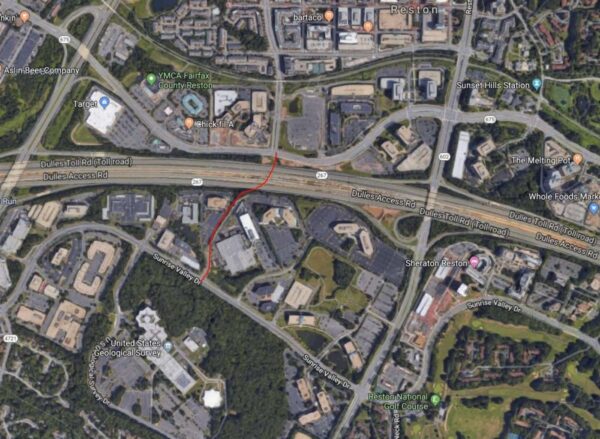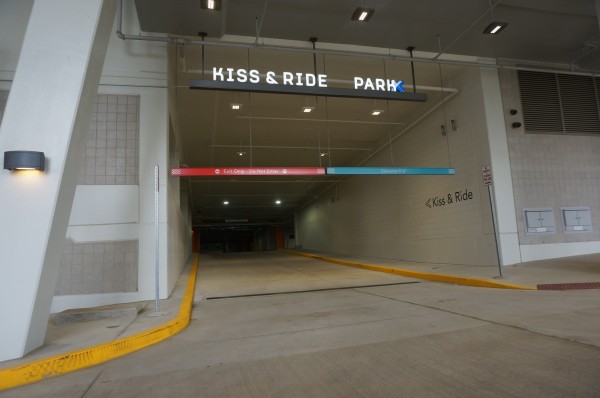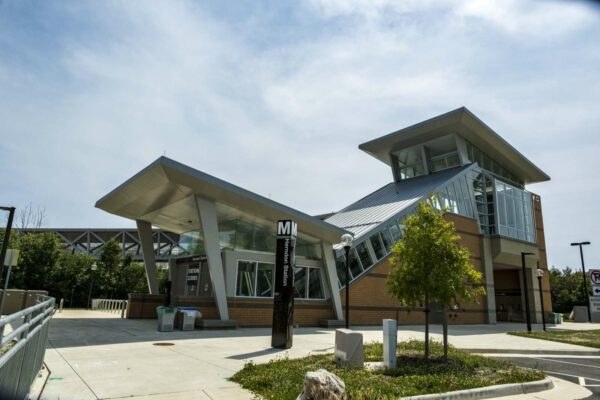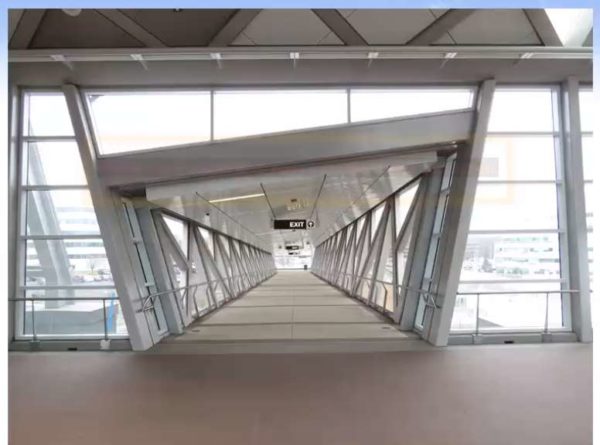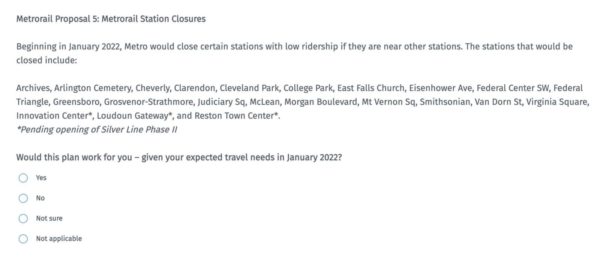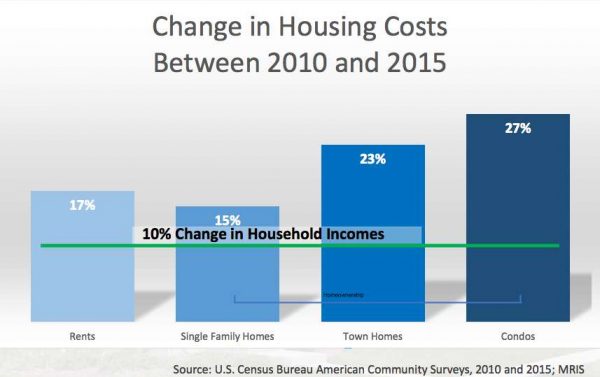Planning for the Town Center Parkway underpass, which would extend the parkway under the Dulles Toll Road, is officially underway.
A $1 million feasibility study complete by consulting firm Volkert has found that the project, which key to relief congestion in the area and near the Reston Town Center Metro Station, is possible.
The project is expected to cost upwards of $166.8 million, the report estimates.
“The construction of this extension is possible but there are many important steps before this can become a reality,” the report states, adding that stormwater management and coordination with Metro officials, the owners of RTC West and RTC Next, and other design constraints could make the project more challenging.
The underpass would run underneath the Dulles International Airport Access Highway and tracks laid down by the Washington Metropolitan Area Transit Authority. Two bridges are proposed to support eastbound and westbound traffic over the Town Center Parkway.
Two signalized intersections would also be needed at the intersections of Sunrise Valley Drive and a future road. Construction would need to be conducted in three phases.
The project extends Town Center Parkway southward from the intersection with Sunset Hills Road to the intersection with Sunrise Valley Drive. Construction of the project would take roughly three years. The study does not set forth a specific construction timeline.
“Fairfax County is pursuing funding for the Town Center Parkway Underpass project. The schedule will not be set until funding is identified and the project is initiated,” Dan Reinhard, senior project manager with VDOT told Reston Now.
|
|
The project was first proposed in 2012 based on a Dulles Corridor Special Study Transportation Analysis and again in the 2018 version of the county’s comprehensive plan for Reston.
The report estimated that a minimum of 255 parking spaces would be impacted by the project — resulting in property damages amounting to roughly $3.4 million. Further evaluation is needed to determine how the project would impact businesses and parking spaces.
The complete report will available online.
Image via Google Maps
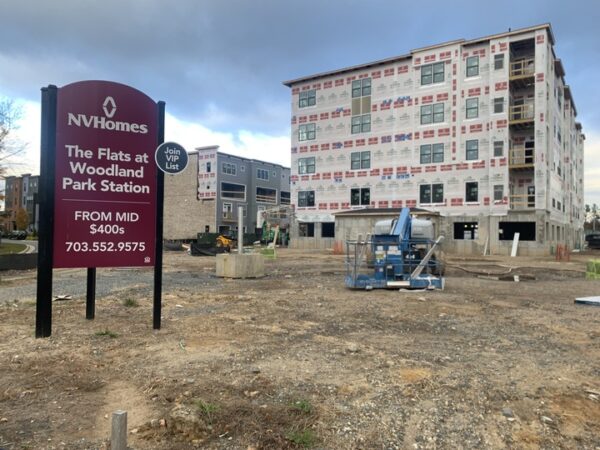
Luxury two-bedroom condominiums starting in the low $400,000s are going up adjacent to an upscale apartment complex, The Ian, near the yet-to-open Herndon Metrorail Station.
The first of four buildings being constructed by NVR, the parent company of NVHomes and Ryan Homes, is slated to open up for sales at the end of this year with anticipated move-ins as early as April, the company tells Reston Now.
The development, dubbed The Flats at Woodland Park Station, includes two bedroom and two-bedroom-den condos, each with two bathrooms per unit. It’s located by a roundabout along Woodland Grove Place.
“Our two-bedroom and two-bedroom-den condos are arriving this Winter, with pricing from the mid $400s to the mid $500s – and these residences include more fine features than you ever imagined possible, plus the convenience of a building elevator serving all levels,” the company says on a promotional page for the development.
To build the four residential buildings with 96 units, the company got the county’s OK in 2019 to amend an approved plan from 2017, which would have involved creating a nearly 211,000-square-foot multi-family building for 148 units. The county’s Planning Commission’s Hunter Mill District representative, John Carter, noted at the time that the change allowed for more open space.
An NVHomes representative said the company expects all four buildings in The Flats at Woodland Park Station to be completed by the end of 2023.
Meanwhile, a 2017 county-approved development plan presented by NVR and New York City-headquartered real estate firm Tishman Speyer called for creating high rises for offices near those residential buildings.
The companies identified a parcel called Block E, abutting the Dulles Toll Road and Monroe Street, for two office buildings with the option for ground-floor retail.
Noting the proximity to the Herndon Metrorail Station, county staff noted a development plan called for office buildings to be 16-stories and 14-stories tall, each with five levels of above-ground parking.
Crews leveled the previously forested area to make way for the developments, and the vacant parcel could be developed with high rises, even as the pandemic has led many companies to rethink the need for the commercial office space that they used to require.
Townhome prices along the Silver Line extension saw prices increase this year, though the real estate industry has noticed pullbacks from a buyer frenzy.
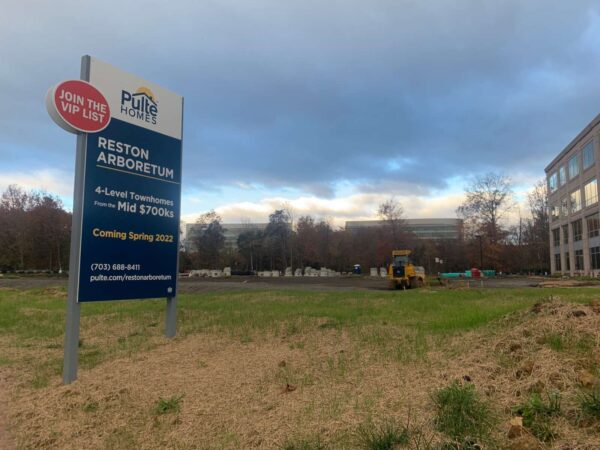
A development for 40 townhomes near the Herndon-Monroe Park & Ride is slated to move forward.
According to Atlanta-based housing developer PulteGroup, which wanted to have model homes ready by late 2020, the project at 12700 Sunrise Valley Drive will have sales in the spring.
As part of the project, a parking garage was built to the right of the existing American Institute of Aeronautics and Astronautics four-story office building. Bethesda-based real estate company JBG Smith has looked to sell the building.
The company is touting the units as four-level luxury townhomes from the mid-$700,000s. The townhomes will generally be located to the southwest of the AIAA building.
Marketing materials promote the development, which the company says offers a walkable lifestyle and “a commuter’s dream” due to access points to the future Herndon-Monroe Metro Station, Fairfax County Parkway, and the Dulles Toll Road. ,
A sign says “Coming Spring 2022,” but according to the company’s website for the project as well as a Zillow listing, that date is when they’ll be available for sale.
A spokesperson for the company, formerly known as Pulte Homes, didn’t immediately respond to a media inquiry.
Meanwhile, development by the proposed Herndon Metro Station could drastically change the northern side of the Dulles Toll Road along the Herndon Parkway.
The town’s mayor, Sheila Olem, said last month during a Dulles Regional Chamber of Commerce event that multiple development scenarios are being considered for 593 Herndon Parkway, where some 222 to 675 units could be built.
The town also agreed to accept $500,000 from a handful of property owners to study how to develop a nearby area, dubbed the Herndon Transit-Related Growth Area, that’s generally north of the Herndon Parkway.
To date, the Washington Metropolitan Transit Authority (WMATA) has been running fare collection at the Wiehle-Reston East Metro Station — a county-owned facility — without compensation.
As a hand-off date for the 11.5-mile extension comes close to fruition, officials are now contemplating the best way for fare collections to continue. In a proposed agreement that goes before the Fairfax County Board of Supervisors today, the county is hoping to compensate WMATA for its efforts by paying roughly $45 per parking space per year.
The county does not own any other garages, a spokesperson for the Fairfax County Department of Transportation told Reston Now.
“We are paying for WMATA to operate the fare collection system in those garages so it is the same for all customers in the county,” said Robin Geiger, FCDOT’s spokesperson.
The yearly payment would amount to around $366,000, with funds largely being offset by parking fees collected at the facilities.
WMATA’s board is expected to take up the matter in a few months.
Wiehle-Reston East has the county’s first county-owned parking facility. With 2,300 spaces, it is the second largest of the new station. The Herndon station will have a 3,751 parking space garage while Innovation Center will have a 2,072-space parking garage.
The parking garage at Innovation Center Metro Station is located on the south side of the station. The $52 million facility was sinking in 2019 and has since been repaired.
The Herndon Metro Station will serve the Herndon-Monroe Park and Ride garage, which has parking for roughly 3,500 cars. The new facility, constructed by Manhattan Construction Co., cost roughly $44.5 million.
The Wiehle-Reston East garage has 2,300 spaces, but some commuters have reported difficulty snagging spots and navigating signs in the garage, especially during early morning hours.
The county’s Board of Supervisors is expected to discuss the issue at a meeting today.
With Silver Line Phase 2 finally reaching substantial completion, the clock has started ticking on when the line will actually open to riders.
Late last week, Metropolitan Washington Airports Authority (MWAA) announced the completion of major construction on the long-delayed multi-billion dollar transportation project that will extend the Silver Line from Reston into Loudoun County with six new stations.
“This is a significant step toward completing the 11.5-mile extension that will provide rail service for residents in Reston, Herndon and eastern Loudoun County and give Metro riders direct access to Dulles Airport,” wrote Jack Potter, MWAA’s president and CEO, in last week’s press release.
This comes about two weeks after work was completed to tie the two Silver Line phases together and the connection of the Automatic Train Control System.
However, the project has not been handed over to Washington Metropolitan Area Transit Authority (WMATA) just yet, an authority spokesperson confirmed to Reston Now.
“Metro looks forward to entering the next phase of the project, during which we will perform hundreds of tests to ensure the extension can be operated safely and reliably before the Board accepts ownership and sets an opening date,” they wrote. “Metro takes full ownership only after the operational readiness evaluation and pre-revenue activities are satisfactorily completed.”
While this is fully expected and doesn’t necessarily impact the timeline for the line’s opening to riders, there are several steps that still need to happen prior to the handover.
First, Metro’s set to conduct about 200 safety tests with any necessary repairs being made. At the same time, Metro’s safety oversight body – Washington Metrorail Safety Commission – will start the certification that the line is safe.
Additionally, the railyard needs to be completed before Metro takes over the project. It currently remains unfinished, both WMATA and MWAA spokespeople confirmed to Reston Now. Hensel Phelps is the contractor for that portion of the project.
When testing, repairs, certification, and the railyard all are done, the Metro Board will vote to take “provisional control” of the project. After that happens, WMATA will set a date to launch passenger service and will begin employee training, simulations, and emergency drills.
In total, this all should take about six months, meaning that a tentative date for opening could be May 2022.
“We’re not projecting an opening date. [It is] dependent on many factors, and the Board will ultimately make that determination,” wrote a WMATA spokesperson.
In the meantime, the public can expect to see more trains running on the line, according to MWAA, as there’ll be a significant increase in testing in the coming months.
While months remain before passengers can catch a ride to Herndon or Ashburn, substantial completion marks a significant milestone for the long-delayed project.
“This is a major step in bringing passenger rail service to Dulles Airport and beyond. And as our residents know well, rail to Dulles has been years in the making,” Hunter Mill District Supervisor (and alternate on the Metro Board) Walter Alcorn wrote in a statement to Reston Now. “The progress of this phase of the Silver Line is made possible by Dulles Toll Road users and landowners who funded most of the project and have waited patiently for this day. I look forward to all parties working together to initiate passenger service during the coming months.”
In September, both Alcorn and Fairfax County Board of Supervisors Chairman Jeff McKay expressed frustration about the project’s constant delays and missed deadlines.
McKay appeared to reiterate his frustration in a statement to Reston Now.
“This is great news from WMATA this week. While the work was still incredibly behind and WMATA has a lot to do to rebuild trust with customers, I’m happy to see that significant [progress] has been made so we can fully open the Silver Line soon,” wrote McKay.
Initially, Silver Line Phase 2 construction was scheduled to be completed in 2018. But contractor issues, design changes, flawed materials, defective panels, and bad concrete all led to the years-long hold up which has tested the patience and viability of local businesses near the stations.
This past week’s good news also comes at a challenging time for Metro, as reduced service continues due to the pulling of 60% of its fleet in response to last month’s derailment.
(Updated, Nov. 9) After years of delays, Metropolitan Washington Airports Authority (MWAA) has announced that it has reached substantial completion on Silver Line Phase 2.
The announcement came Thursday afternoon and nearly two weeks after the successful tie-in of the two lines at the Wiehle-Reston East Metro station
MWAA is preparing to hand over the $2.8 billion public transportation project to Washington Metropolitan Area Transit Authority (WMATA). Metro currently owns the project and still has sole responsibility for the project until Metro assumes ownership.
WMATA has confirmed to Reston Now that the agency will still need about six months to complete testing and pre-revenue preparations before opening to riders. However, they are not yet setting an official opening date.
“Metro looks forward to entering the next phase of the project, during which we will perform hundreds of tests to ensure the extension can be operated safely and reliably before the Board accepts ownership and sets an opening date,” writes a WMATA spokesperson to Reston Now.
If that six month timeline does remain accurate, Silver Line Phase 2 should open to riders in May 2022.
From MWAA’s press release:
Silver Line Phase 2 Reaches Major Milestone
Metropolitan Washington Airports Authority officials announced Thursday they have declared substantial completion for work by Capital Rail Constructors (CRC) on Phase 2 of the Metrorail Silver Line extension project. The work by CRC, a joint venture led by Clark Construction Group and Kiewit, is a key component of the project to extend the region’s Metrorail public transit system to Dulles International Airport and beyond.
Substantial Completion means major construction is complete and allows operational readiness testing to begin, during which the contractor will demonstrate the project’s functionality, as a key step toward delivering the new rail line to the Washington Metropolitan Area Transit Authority, which operates the Metrorail system.
“This is a significant step toward completing the 11.5-mile extension that will provide rail service for residents in Reston, Herndon and eastern Loudoun County and give Metro riders direct access to Dulles Airport,” said Jack Potter, president and CEO of the Airports Authority. “In addition to providing new public transportation options, the Silver Line is a major catalyst for jobs and economic development in the National Capital region.”
The project also includes a 90-acre rail maintenance yard at Dulles International Airport, being built by Hensel Phelps, which is also nearing completion under a separate contract.
Phase 1 of the Silver Line opened in 2014, extending Metrorail service from East Falls Church to the eastern edge of Reston and triggering major transformations in the Tysons Corner and Wiehle Avenue areas. Those same trends are beginning along Phase 2, with changes already underway along the Dulles Corridor in Reston, Herndon and Ashburn, and at Dulles International Airport. The Silver Line’s goal is to help ease traffic congestion by providing alternative routes and easier commuting times, access to regional entertainment, shopping and Dulles Airport.
In a statement, contractor Capital Rail Constructors calls this a “significant milestone.” Here’s more from Keith Couch, the company’s project director:
“After successful Phase 1 and Phase 2 tie-in testing at Wiehle Avenue, MWAA has approved substantial completion of the Package A Silver Line Phase 2 project. The project will now move into Operational Readiness Testing, which will be completed by MWAA and WMATA. This significant milestone is a testament to the hard work, dedication, and collaboration of the project team and stakeholders. The CRC team is proud to have been a part of this transformational piece of infrastructure for the region.”
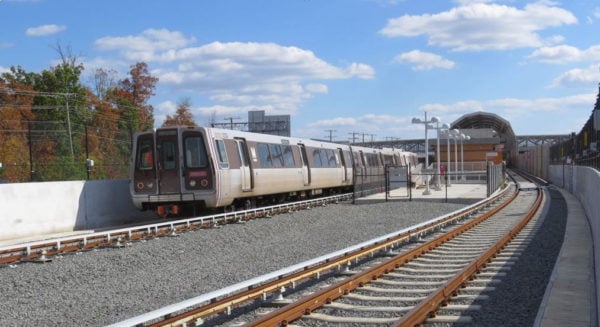
Metro service changes announced last week — including increased services, late night hours, and reduced fares — are being praised by many in the community.
On Thursday (June 10), the Metro Board approved a host of improvements with the intention of luring back riders after more than a year of reduced services and free-falling ridership.
The changes include more frequent service during both peak and non-peak times, extending operating hours until 1 a.m. on weekends, a flat $2 weekend rate, and free transfers between bus and rail.
The changes will take effect starting Labor Day weekend, the traditional end of the summer.
“These are all very positive changes,” Hunter Mill District Supervisor Walter Alcorn told Reston Now. “The only thing that made these service improvements possible is the money from our federal partners. Because Congress stepped up and delivered, we’re able to make these service improvements and, frankly, do what needs to be done to help build back ridership.”
Metro received nearly $723 million in federal COVID-19 relief funds, including $193 million from the American Rescue Plan enacted in March. These funds not only prevented severe cuts, but allowed Metro to increase services while cutting fares.
Local labor unions are also pleased with the changes, including ATU Local 689, which represents more than 10,000 regional transit workers and said it “strongly supports” the service increases.
“We know that public transit is a safe and effective way for riders to get where they need to go, but we have to do the work to rebuild rider confidence,” ATU Local 689 President Raymond Jackson wrote in an email to Reston Now. “The first step to this is making sure that passengers know there will always be a bus or train there for them when they need it. That requires full service. We’re proud that WMATA took this step.”
Alcorn says that, during the pandemic, cuts to service were a “significant hardship” for those who couldn’t work from home, like hospitality workers, who often need rail and bus service at different times than those in other industries.
“We realized that, in the middle of the pandemic, that there’s still a lot of folks that depend on transit to get to work and to do what they need to do to get around,” Alcorn said.
John Boardman is executive secretary and treasurer for Local 25, a union that represents about 7,000 people who work in hotels, casinos, and restaurants in the D.C. metro region. He says expanding services is inherently beneficial to their members.
“Our jobs are not 9 to 5 jobs. They start early in the morning and can go late into night,” Boardman said. “More transportation and longer hours helps our workforce. Reliable transportation is one of the issues that affects people’s ability to get back to work.”
Increased service and fare cuts will also greatly benefit those most vulnerable in the community, such as the clients the D.C. Reentry Action Network, a regional organization that assists people being released from prison.
“Any reduction in the cost of transportation would contribute greatly to reducing the already tremendous hurdles one faces when returning home,” founder Paula Thompson told The Washington Post.
Metro admits it could still take years for ridership to return to pre-pandemic levels. A graph presented at the transit agency’s June 10 board of directors meeting estimates that even by the end of 2024, ridership may still be off by as much as 25% from late 2019 levels.
But it’s hoped that these changes could at least spur gradual growth. Read More
(Updated, 4:20 p.m.) Metro’s Board of Directors is set to approve a $4.7 billion capital and operating budget on Thursday (April 22) that includes $723 million in federal relief.
The influx of federal funds essentially renders concerns about drastic service cuts set to come in January 2022 moot. Those cuts would have potentially included closing 22 Metro stations across the system, shutting down Metrorail every day at 9 p.m., and limiting train arrivals to every 30 minutes at most stations.
Among the stations that were being proposed to close in 2022 were three yet-to-be-opened Silver Line Phase II stations — Innovation Center, Loudoun Gateway, and Reston Town Center.
Metro officials are now assuring the public that this possibility has now been taken off the table.
“If the Board does adopt this budget, I think it’s an important message to the entire community that these cuts are not coming,” Washington Metropolitan Area Transit Authority General Manager Paul Wiedefeld said at Metro’s Finance and Capital Committee meeting on April 8.
Instead, as the proposed budget states, current Metro services will maintain at their current level for at least another full year.
If adopted, the budget will also officially push back the start of service on the second phase of the Silver Line until January 2022 at the earliest.
The budget notes that “substantial completion” of the line is expected by Labor Day weekend, when the Metropolitan Washington Airport Authority says it will be able to hand over the project to WMATA.
Last month, Hunter Mill District Supervisor Walter Alcorn told Reston Now that he was relieved federal relief will save Metro from making drastic service cuts.
“While the WMATA board is working to finalize the FY2022 budget, the Silver Line Phase 2 will now open whenever it is ready and because of the federal funds all Metrorail stations will stay open,” Alcorn said in a statement.
Delaying Silver Line Phase II from the July opening planned in WMATA’s fiscal year 2021 budget will also save Metro money. At a work session in February, operating costs for Silver Line Phase II were estimated to be about $120 million annually, or $10 million a month.
The delay will likely amount to about $46 million in savings after factoring in retention costs like security and ongoing maintenance, which are about $28.5 million annually, or $2.38 million a month — even when stations and trains are not operational.
Metro will get about $723 million in federal COVID-19 relief funds, including $193.4 million from the American Rescue Plan Act (ARPA) just enacted last month. In addition to sparing Metro from making drastic cuts, the funds will provide money to individual jurisdictions for infrastructure projects in WMATA’s capital improvement program.
Fairfax County is set to receive $40.6 million from Metro’s fiscal year 2022 budget for these projects and potentially $269 million over the next six years, the most of any Virginia jurisdiction.
While most of the questions that Metro asked in their public survey when first opened at the end of February are now moot, the transit authority still received a lot of responses.
Metro received more than 22,400 comments, the most in at least a decade for a budget public survey.
However, most of those comments came from Metrorail riders, even though Metrobus currently has more riders. Of those 22,400 comments, only 17% came from Metrobus riders, 5% from low-income respondents, and 24% from minority respondents.
In response to the now-moot questions about service cuts, most were not in favor of any of the more drastic ones.
Only 13% were in favor of closing up to 22 stations, and 30% were in favor of service stopping at 9 p.m. The 30-minute wait for trains was a more accepted drastic service cut with 44% of respondents in support, 44% opposed, and 12% not sure.
Yellow and Red Line turnbacks, which means fewer trains would go to the end of the lines, were the most popular service cuts, with more than 55% of respondents favoring it.
Photo courtesy Metropolitan Washington Airports Authority

Metro Proposes Delaying Funding for Silver Line Phase 2 — Unveiled yesterday (Monday), Metro General Manager Paul Wiedefeld’s revised FY 2022 budget proposal confirms that the second phase of the Silver Line will not open this year, though the Metropolitan Washington Airports Authority has maintained that the project will be ready for Metro to take over by Labor Day. [ABC7-WJLA]
Reston Woman Charged with Assault after Barricade — Fairfax County police arrested a woman on Sunday after she barricaded herself in an apartment on the 2200 block of Stone Wheel Drive in Reston. The hours-long standoff began when officers arrived to investigate a reported domestic assault and serve a warrant to 29-year-old Iesha Walker, who police say threatened to burn the building, shoot officers, and harm a family member and acquaintance who were in the apartment with her. [FCPD]
Reston Tech Company Partners with Baltimore Ravens — Leidos and the Baltimore Ravens will donate funds to support Oxford House in Silver Spring for the second year of their “Tackling Opioid Addiction” campaign, which aims to raise awareness about the ongoing opioid epidemic. [Baltimore Ravens]
Herndon Student Wins Statewide Art Contest — Sarah Saravanan, a first-grade student at McNair Lower Elementary School in Herndon, won the Virginia Lottery’s Thank A Teacher Art Contest, which invites students to create art that will be showcased on “thank you” notes sent to during National Teacher Appreciation Week on May 3-7. [Patch]
Photo by Ray Copson
Metro’s Board of Directors is still proceeding as if the Silver Line Phase II will open this year, but a public survey is asking riders to weigh in on drastic service cuts, including closing the newly-opened Phase II stations in Janurary 22.
Last week, Metro announced that the public comment period for its 2022 fiscal year budget has officially opened.
As part of that, they’re asking riders to fill out a survey about what extreme service cuts they’d be willing to tolerate beginning on Jan. 1, 2022 if additional federal money is not available.
In these options is a question about the closing of 22 stations across the entire system, including two Silver Line stations – McLean and Greensboro – and three potentially newly-opened Silver Line Phase II stations – Innovation Station, Loudoun Gateway, and Reston Town Center.
Although the 2021 budget says that Phase II could open July 1, 2021, it could be delayed until, at the earliest, the fall.
At last week’s budget work session, an tentative estimate was noted as early November.
A Metro spokesperson tells Reston Now there’s “no clear answer yet” about an opening date, however the Metro Board has to proceed as if it will open in 2021 in order to pass the 2022 budget.
“The Board will take all public feedback into consideration before approving a final budget for FY22,” writes the spokesperson.
So, it is possible that the Silver Line Phase II could open this year, only for the stations to close a few months later due to the budget shortfall.
Complicating the situation is that Silver Line Phase II and the proposed drastic service cuts are essentially on two different timelines.
Earlier this month, Metro’s staff presented an update on 18 different safety and operational issues previously noted in December.
Of those 18, 17 were still in the midst of being resolved or remained unresolved. They range from maintenance issues with the station platform pavers to several thousand damaged track fasteners that need replacing to cracked third rail insulators.
The Metro spokesperson confirms that resolving these safety and operational issues have a greater impact on the timeline for the opening of the Silver Line Phase II than the budget shortfall in 2022.
In fact, Metro’s funding for Phase II construction hasn’t really been impacted by Metro’s overall financial woes.
“The Metro board has not done anything to delay the opening of Phase II as a matter of Metro policy or budget policy,”Metro Board of Supervisors member Matt Letourneau told Reston Now in January. “Thus far the position of the Metro board has been whenever the project is…. deemed acceptable and safe, and gone through testing, we should open it.”
That’s not to say that the Silver Line Phase II won’t cost Metro money that needs to be accounted for in the 2022 budget.
At last week’s work session, it was noted that operating costs for Phase II are about $120 million annually, or $10 million a month.
If it is delayed to November 2021 due to safety and operational issues, that would save Metro about $40 million.
However, retention costs like security and ongoing maintenance are $28.5 million annually or about $2.38 million a month — even if the stations and trains are not running and operational.
In the end, if Silver Line Phase II does not open in early November and gets delayed until additional federal funding does come through, it could save Metro about $7.5 million a month.
Metro is continuing to plan the 2022 budget under the prospect that they will not receive additional federal funding, though.
The most recent coronavirus relief package provided Metro more than $600 million in federal funds. That funding, notes Metro, helped avoid layoffs and provide essential services.
But even with that funding and other austerity measures, “there is not enough money to fill the entire budget gap for the fiscal year that begins July 1, 2021,” Metro’s press release reads.
Hence, the potential need to close 22 stations, including the possibly-just-opened Silver Line Phase II stations.
Among the other options for service cuts asked in the survey is closing Metrorail every day at 9 p.m. and trains arriving only every 30 minutes at most stations.
Metro is asking riders to fill out the survey by Tuesday, March 16 at 5 p.m.
There’s a decent chance, however, that these worries over closing stations on Jan 1, 2022 could become moot.
President Biden’s $1.9 trillion stimulus plan has $20 billion earmarked for public transit agencies.
At this time, however, it remains unclear how much would go to Metro if the plan does pass in Congress.
Photo courtesy Metropolitan Washington Airports Authority
The COVID-19 pandemic has impacted every facet of the world including Metro planning, but officials say the construction phase of Phase II of the Metro Silver Line has managed to stay on track.
Marcia McAllister, the Dulles Corridor Metrorail Project Communications Manager, noted that Phase II is 99 percent complete. McAllister shared the update during the Dulles Regional Chamber of Commerce’s Metro Monday Jan. 25 virtual meeting about COVID-19’s financial impact on Metro and the Silver Line.
“COVID has had very little effect on our construction,” McAllister said. “As you know, construction workers were allowed to continue to work and they did work, and our contractors have put in extra hours to make up any time they may have (needed) when they may have had cases of COVID.”
She added that the project is undergoing system testing and that coordination is happening daily with Metro moving forward. While the project’s eventual opening will be up to WMATA, the goal is to turn it over to the Metropolitan Washington Airport Authority in late spring.
When Metro takes control of the project, it will conduct its own testing before opening the second phase. During a Metro Monday meeting on Dec. 10, head of capital delivery for Metro Laura Mason estimated that Phase II’s tentative start of service would begin in the fall of 2021. The completion of the project has been delayed by more than a year.
McAllister also addressed rumors about the construction budget funding for the project.
“Our funding is completely intact. There’s been no change in the allocation of funds,” she said. “In fact, we have already spent all of the Phase I money that came from the federal government to fund this project. That part is set in golden stone.”
Loudoun County Supervisor and Metro Board of Supervisors member Matt Letourneau reiterated McAllister’s budget comments and clarified that the construction budget for the project is not related to Metro’s capital budget. Letourneau went into further detail on Metro’s financial standing during the ongoing pandemic and the federal COVID-19 relief package signed on Dec. 27 to support transit.
The overall region is expected to receive about $830 million, with about $720 million going to Metro. Metro will keep about $600 million of the funds and allocate about $108 million to local providers.
“That will allow us to essentially balance the FY (fiscal year) 21 budget with about $95 million of that,” Letourneau said. “We had planned some fairly significant, but not necessarily painful, cuts coming in February that we’re going to be avoiding.”
The remaining $515 million allocated to Metro will be used to help balance the fiscal year 2022 budget. Metro will pass a budget in the mid-March to early April timeframe. However, Letourneau cautioned that the federal funds would not cover the entire fiscal year 2022 budget.
Unless additional federal funding is received, Letourneau said, service cuts and employee layoffs are potential threats in January 2022. He estimated that the layoffs could encompass an estimated 2,500 people.
“The Metro board has not done anything to delay the opening of Phase II as a matter of Metro policy or budget policy,” Letourneau said. “Thus far the position of the Metro board has been whenever the project is been turned over and deemed acceptable and safe, and gone through testing, we should open it.”
Since the inception of the pandemic, Letourneau estimated that Metro rail ridership is between 10 and 15 percent of what it was prior to COVID-19, while bus ridership is around 50 to 60 percent. He added that if additional federal funding is not provided, the fiscal year 2022 budget process will involve considering $171.4 million service reductions for the last six months of the fiscal year.
Hunter Mill District Supervisor Walter Alcorn urged officials to open phase two as soon as it is ready and practical.
“As we think about the Metro budget and going forward, we have to keep in mind that the long term viability of Metro depends on using rail,” Fairfax County Supervisor Walter Alcorn said.
Letourneau echoed Alcorn’s statement by that saying Phase II should continue as previously planned despite challenges and low ridership.
“If we are trying to recover, if we want to be part of that recovery, we know that the highest growth part of the system is the silver line; it is the Dulles corridor,” Letourneau said.
The WMATA Board voted to authorize a public process to participate in discussions on the fiscal year 2022 budget in February. Hearings are anticipated to begin in early March and the board is then expected to approve a budget in April.
Photo by Chuck Samuelson/Dulles Corridor Metrorail Project
Fairfax County is seeking public input on proposed Fairfax Connector changes that could dramatically alter bus service in the area as part of the county’s ten-year Transit Strategic Plan.
The proposed changes would impact a number of Herndon-Reston routes and create new ones, including Sterling-Herndon and Reston Town Center Metro station (when it finally opens) to Herndon High School.
The goal of the changes is to provide better access to destinations, improve travel times, increase schedule reliability and frequency, and increase overall services, according to the county’s press release.
The county is also looking to provide more access to schools, hospitals, and transit centers, decrease average travel times on popular routes, and to improve efficiency by cutting duplicating connections. Changes would be “initially developed as budget neutral,” according to the county.
There will be three virtual community input meetings next week (Jan. 12, 13, and 14) and public comments will be accepted until Feb. 21.
To increase participation, Fairfax County Department of Transportation is mailing out a brochure to every county resident this month that will direct people to the online survey. The brochure is also translated into nine different languages. The public has already had some chance to comment on a number of the subareas, including the Herndon-Reston routes, according to Robin Geiger, a spokeswoman for the Fairfax County Department of Transportation.
Due to this, these particular route updates can go to the Board of Supervisors and will be implemented prior to the entire transit strategic plan. These route changes and updates are expected to be approved and ready to go for when phase two of the Silver Line, Geiger tells Reston Now, since it incorporates two Metro stations into the routes.
Silver Line Phase 2 is currently scheduled to open in the fall, at the earliest.
However, if residents would like to comment on the Herndon-Reston routes and how they will be incorporated into the county’s overall transportation plan, Geiger says they are welcome to do so.
“We want to hear from everyone,” she says.

South Korea’s Hyundai Group Sells Reston Office Campus — “An affiliate of Boyd Watterson Asset Management has paid $325 million for Patriots Park, a Reston office park leased to the Office of the Director of National Intelligence, adding to a growing portfolio of properties it owns in the D.C. region.” [Washington Business Journal]
Range of Assessment Options Explored in Hearing — “The Reston Association Board of Directors will discuss different scenarios for setting the 2021 assessment rate between $708 and $728 at a public hearing on Nov. 4. The board requested that RA staff explore a range of assessment rates, and how the extra money would be spent, at its regular meeting on Oct. 22.” [RA]
Opinion: Politics Messed Up Silver Line Phase Two — “But perhaps the most remarkable thing about Phase 2 is not how badly the project has been bungled but how few people seem to be concerned about the mess that is being made. No elected officials are speaking out, and the stories detailing the excruciatingly long list of problems with the project are relegated to the back pages of newspapers.” [The Washington Post]
Photo via Marjorie Copson
Given that the expansion of the Silver Line is expected to bring more people to already urbanized areas in Northern Virginia, community leaders are working toward solutions around the lack of affordable housing.
The Dulles Chamber of Commerce brought together representatives from Fairfax and Loudoun counties to talk about what this means for the future of affordable housing at a public meeting yesterday evening. Common themes of conversation included roadblocks to construction, current demand for units, land-use policies and even the type of people around town in need of subsidized housing.
The cost of living is not sustainable for lower-income people working in the area, according to Tom Fleetwood, the Director of Housing and Community Development for Fairfax County. Around Fairfax County, from 2010 to 2015, the average income only increased by 10% while the cost of housing increased by 17%.
Fairfax County will require at least 15,000 new affordable housing units in the next 15 years to support families earning 60% of the median income and below, according to Fleetwood.
Currently, there are 30,000 low-income renters in Fairfax County that are paying more than one-third of their income on housing. “This means that they’re what we call a cost-burden and that they have less money to contribute to our economy,” he said.
According to the National Low Income Housing Coalition, four minimum wage jobs are needed in order to afford the average apartment in the county.
Once the extension project is complete, the housing disparity is only expected to grow.
In Tysons and Reston specifically, Fleetwood said that the biggest challenge is the limited availability of land for affordable housing projects. To combat this, updated inclusionary zoning policies have been a large help in rethinking how space is used, he said.
“Visionary zoning policies have produced a substantial number of below-market units that are serving working families in Tysons and in Reston,” Fleetwood said but didn’t volunteer a specific number.
Stephen Wilson, president of the SCG Development, offered previous examples at the meeting of how his company has worked around small parcels of open land, using creative designs in areas like Shady Grove to make the most of space.
“Land is a precious commodity everywhere, but particularly around high-density areas,” he said.
At Ovation at Arrowbrook in Herndon, SCG Development is branching out and working with community planners to incorporate affordable housing close to stations like Innovation Center.
Image courtesy Fairfax County
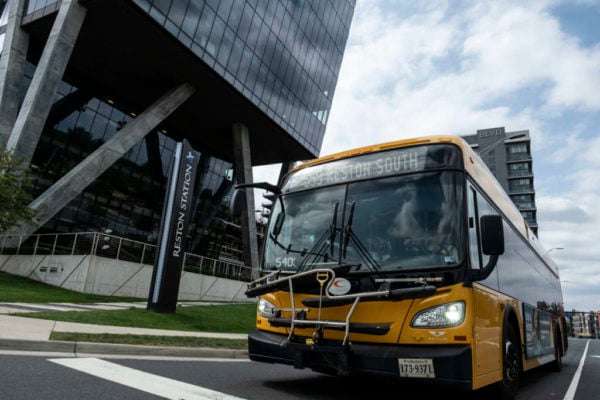
The Fairfax County Department of Transportation has selected its preferred bus service plan for the Fairfax Connector in Reston and Herndon.
County planners say the plan “aims to improve on-time performance and streamline service to meet the needs of the community and commuters.”
Here’s more from FCDOT on what’s being considered:
Some of the key improvements to the bus service in the area include new and more direct connections and routes; new connections to Chantilly, Centreville and the Dulles Corridor; service to Northern Virginia Community College (Loudoun Campus); and routes travelling from Sterling to Herndon. The plan, which also uses elements from all three of the proposed alternatives, shortens travel time, increases access for transit dependent populations, and maintains bus stop coverage at most locations.
The implementation of the proposed service changes will coincide with the start of the new Metrorail Silver Line service and will provide connections to the Reston Town Center Station, Herndon Station, Innovation Center Station, Dulles Airport Station, Loudoun Gateway Station and Ashburn Station.
The plan will include three new routes: Chantilly to the Dulles Corridor, Northern Virginia Community College’s Loudoun campus, and Sterling too Herndon. Planners say the proposal shortens travel time and creates more direct connections.
The average travel time could be reduced from 57.3 minutes to 49.4 minutes. The updated plan would also improve service to more households, especially those that are low-income.
More information about the proposal is available online.
The county is seeking feedback via an online survey and via email at [email protected]. Residents can also call the county at 703-877-5600, extension 711, or mail comments to 4050 Legato Road, Suite 400.
The county is also hosting a virtual public meeting on the plan with Hunter Mill District Supervisor Walter Alcorn and Dranesville District Supervisor John Foust on Wednesday, July 8 from 6:30-7:30 p.m.
Staff photo by Jay Westcott


